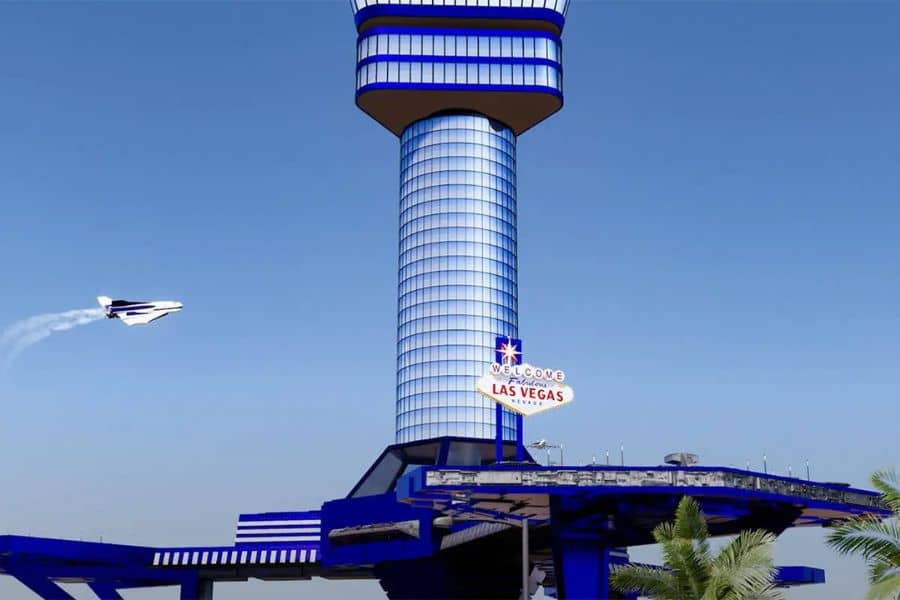
Nevada is preparing for a major leap forward with the proposed Las Vegas Spaceport, a project that could make the state a leader in space tourism and aerospace technology. Led by real estate developer Rob Lauer, this $320 million spaceport will be built on a 240-acre site near Pahrump, about 50 miles west of Las Vegas.
The project is expected to bring new jobs, more tourists, and exciting opportunities in science and technology. Plans include spaceflight training, commercial hangars, a STEM academy, and visitor facilities like a hotel and observation deck. In May 2024, the Clark County Board of Commissioners approved the first phase, allowing an airstrip to be built as the first step toward full development.
If successful, the Las Vegas Spaceport could strengthen Nevada’s economy, attract new businesses, and position the state as a leader in the expanding space industry.
Project Overview
The Las Vegas Spaceport is a $320 million project designed to support various facets of the space economy. Key planned features include:
- Civilian Space Flight Training – Programs to prepare individuals for space travel, offering hands-on simulation experiences.
- Commercial Hangars – Construction of 40 hangars to house space vehicles and facilitate aerospace activities.
- STEM Academy – A specialized science, technology, engineering, and mathematics (STEM) institution equipped with advanced flight simulators.
- Hospitality Services – A hotel, passenger terminal, rooftop observation deck, and restaurant to enhance the visitor experience.
These facilities are expected to attract a wide range of visitors, from space enthusiasts and future astronauts to engineers, educators, and investors. The spaceport’s initial approval for an airstrip is a critical first step, with further development contingent on additional approvals and funding.
Economic Benefits for Nevada
The Las Vegas Spaceport has the potential to significantly boost Nevada’s economy by generating new employment, investment, and tourism opportunities. Some key economic benefits include:
1. Job Creation
The spaceport’s development and operational phases will generate thousands of jobs across multiple industries, including:
- Construction – Building infrastructure, hangars, and hospitality facilities.
- Aerospace and Engineering – Hiring experts in spaceflight technology, aircraft maintenance, and research.
- Education and Training – Employing instructors, pilots, and specialists at the STEM academy.
- Hospitality and Tourism – Creating positions in hotel services, dining, and event management.
2. Boosting Tourism
Tourism is a key part of Nevada’s economy, and the spaceport will add a unique new attraction that could draw visitors from around the world. Spaceflight training programs, simulated experiences, and educational tours will draw visitors from around the world, further strengthening Las Vegas’s reputation as a global entertainment and innovation hub.
3. Attracting Investments
The growing commercial space industry, led by companies like SpaceX, Blue Origin, and Virgin Galactic, has attracted billions of dollars in investments worldwide. The Las Vegas Spaceport could position Nevada as a key player, encouraging both private and government funding to flow into the region.
Impact on Nye County
While Nevada as a whole stands to benefit, Nye County, where the spaceport is located, is expected to experience direct economic and infrastructural growth.
1. Business and Real Estate Growth
- Increased demand for hotels, restaurants, and services to cater to spaceport visitors.
- Rising property values due to new developments and job influx.
- Increased interest from technology and aerospace companies looking to set up operations nearby.
2. Educational Advancements
- The STEM Academy will provide students and professionals with specialized training in aerospace and aviation.
- Opportunities for partnerships with universities and research institutions, strengthening Nevada’s education sector.
3. Infrastructure Development
- Improved transportation, roads, and public services to accommodate increased activity.
- Possible upgrades to water and energy systems to support spaceport operations.
Infrastructure and Land Development Impact
A project of this scale requires significant land surveying, zoning adjustments, and infrastructure planning. The Las Vegas Spaceport will:
- Drive demand for land surveyors and civil engineers to map, design, and assess the suitability of the terrain.
- Influence zoning laws and land use regulations, potentially transforming surrounding areas into commercial hubs.
- Lead to road expansions and new utility systems, enhancing overall accessibility and livability in the region.
Challenges and Considerations
Despite its promising economic potential, the Las Vegas Spaceport faces several challenges that must be addressed:
1. Water Resource Management
- Nye County is already dealing with water supply concerns.
- Sustainable water conservation plans will be essential to avoid straining local resources.
2. Funding and Investor Confidence
- While investors have shown interest, securing the full $320 million in funding remains a challenge.
- The project must demonstrate long-term profitability and viability to attract continued investment.
3. Community Engagement and Regulatory Approvals
- Ensuring local support by addressing residents’ concerns about environmental impact, noise, and land use.
- Navigating FAA regulations and environmental assessments before full-scale development can proceed.
The Las Vegas Spaceport is more than just an idea—it’s a big opportunity for Nevada’s economy. It could bring new jobs, boost tourism, increase real estate value, and improve infrastructure, turning Nye County and Southern Nevada into a center for space innovation.
However, for the project to succeed, challenges like water supply, funding, and community support must be addressed. With support from investors, government leaders, and the community, Nevada can turn this vision into a thriving space industry and a stronger economy.
